Block substitution
I am not very fond of "named weaves", since the names often are fancy rather than descriptive. "Names" can be used as a convenient shorthand, but only if they are defined, or known to all parties in a discussion. I have had numerous terminology discussions on both the Internet weave lists I am on - and it has become obvious that my views sometimes are radically different from the views many of the Americans hold.
When I suggested this topic, I was thinking of how many ways there are to understand the "rules" of a (any)
"named weave" - how many different detail structures can result from one block pattern, while still staying
inside the rules of the structure.
So, first some starting points:
- a "named weave" to me means a defined structure, i.e. the structure of the cloth. The, for example, 2/2 twill is the same whether I used 4 or 24 shafts, 4 or 24 treadles, whether I had a straight or broken draw, and so on.
- as a result of the above, I have never been able to understand phrases like "twill woven as plain weave" - a twill is a structure, and so is plain weave.
- the same must be applicable to "fancy" named weaves, if we are to understand each other - if, for example, "monk's belt" means a supplementary weft that floats either over or under a plain weave foundation, then a structure that has a supplementary weft that either floats or is caught in a shed can't be called "monk's belt".
- if we are to use "names", we need to define them in a way that others can understand what structures we are talking about.
For various reasons, I wanted to know what constitutes the "named weave" jämtlandsväv.
I went to three Swedish books - Cyrus-Zetterström: Manual of Swedish handweaving, Getzmann: Bindningslära 1 och 2
(not translated), and Eriksson, Gustavsson, Lovallius: Varp och inslag (not translated). I also looked in the book
Jämtlandsdräll, but it had no section on theory. It proved to be frustrating to try to "dissect" the
recipes to find out details about the rules used.
All three agreed that jämtlandsväv is a supplementary weft weave on a plain weave foundation, on four shafts.
It can have two, three or four blocks. Blocks can weave independently or two together, but never three together (when
looking at the block, or profile, draft). Blocks are woven as shown in the profile, one pattern treadle alternating by
tabby, until the woven block is the desired height. When two blocks form pattern simultaneously, the tie-up has to be
determined by selecting the "best" combination of two of the three possible shafts for each pattern treadle.
(I asked Gustavsson and Lovallius for their thoughts on an 8-shaft, 8 block weave with otherwise same structure -
Gustavsson thought it should not be called jämtlandsväv, Lovallius wanted to think about it.)
Of the American books I have, I looked in Davison: A handweaver's pattern book, Tidball: The weaver's book and some
articles in Handwoven. I also used the "block substitution" feature in two software programs I have, PCW Silver
and ProWeave.
Davison has no theory, and "dissection" was as frustrating...
Tidball implies it can only have an even number of blocks, two or four, and says that only one block can form pattern at a
time (as seen in the profile draft). She also says some things I don't recognise from the Swedish usage of
jämtlandsdräll - "[...] since few crackle threadings are woven as drawn in [...]"
and "[...] the classic crackle method omits the tabby and follows the rhythm of the draft with the use of
three shuttles, each carrying a different color of thread."
ProWeave does not allow odd number of blocks. It also uses one standard tie-up regardless of what the profile says, with
no comments, and also uses Tidball's "standard" treadling.
PCW substitutes the threading in the same manner as does ProWeave (and Tidball). There are different "treadling
methods" available. According to my Swedish books, I chose "block form". The tie-up varies with the
profile tie-up. This means if the profile has three blocks in the threading, the detail tie-up only ties three shafts.
If the profile only has three treadling blocks, the detail tie-up has three blocks - though how these pattern-tie-ups are
determined I have not understood.
Even the actual block substitution rules differ:
Cyrus-Zetterström has a discussion about incidentals - her method minimises the number of ends (total), by trying to
skip incidentals and "transition threads" whenever possible: a block that starts with a tie-down thread should
not end with one, and thus the next block should start without the tie-down. If the blocks do not come in straight
progression, an end is skipped rather than added at the transition.
Getzmann has different rules - in book 1 she prefers skipping transition ends if possible, in book
2 she says they should be kept, especially if the block consists of only four ends.
Eriksson-Gustavsson-Lovallius keep all tie-downs, add transition ends if needed.
All American sources do the same, if discussed at all.
The order of the blocks, and the details, differ, too:
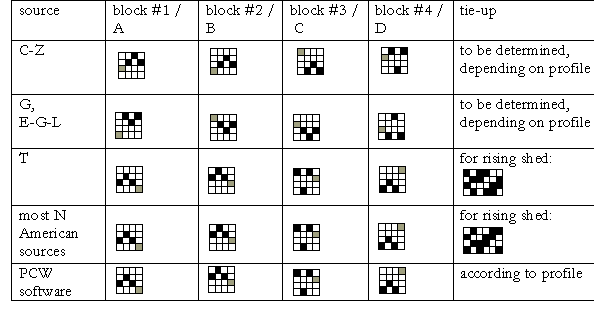
Do these differences matter?
Well - if we agree that the pattern on the resulting cloth should resemble the profile draft, it certainly does.
I have made some detail drafts starting with the same profile, which I took from the Eriksson-Gustavsson-Lovallius book:
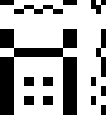
This is how it looks if I do a manual substitution according to the rules in that same book (black warp, grey tabby, white pattern weft):
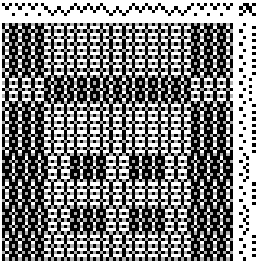
In the detail drawdown we can still see the profile pattern.
This is how it looks if I do a manual substitution according to the rules of Cyrus-Zetterström:
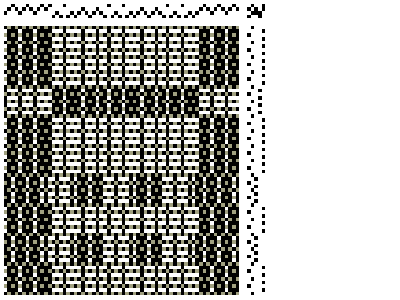
The number of ends is down from 71 to 64. In the detail drawdown we can still see the profile pattern, after I have
"determined the tie-up": "the harnesses must be tied to the treadles so that three of four threads are
lowered from the pattern forming blocks, while only one of four threads is lowered from the other blocks".
(p 79 in the 2nd U.S. edition 1977)
We can see that the block threading in E-G-L gives better result for this profile.
This is how it looks if I do a manual substitution according to Tidball, with T's three-colour-sequence:
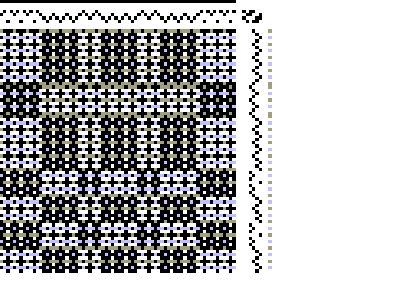
We have no resemblance between the profile patterning and the pattern in the detail draft.
If I let ProWeave do the substitution, I have to add one blank row to the threading and one to the treadling to comply with the PW rule "only even number of blocks". Naturally, I get different results depending on where I add the blank "shaft" and "treadle".
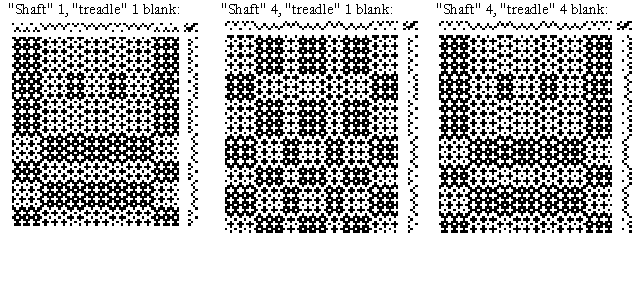
As with the Tidball method, we have lost the resemblance between profile and detail.
Finally, this is how it looks like if I let PCW do the substitution (black warp, grey tabby, white pattern):
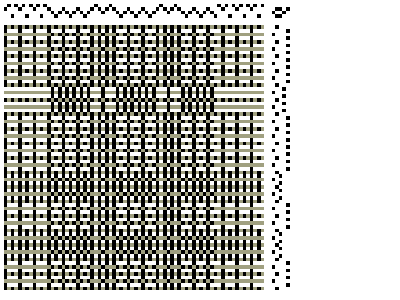
Again, the profile pattern can not be seen. Many ends/picks do not interlace properly, due to the fact that the tie-up only takes care of three shafts, even though the threading is spread over four. Extending the tabby tie-up over all four takes care of that, but still we do not see the profile pattern.
Conclusion 1: there are many different ways to do a substitution of the same profile draft into the same "named weave", while staying inside the same basic rules. Different methods can give very different results as to how the pattern from the profile draft shows in the cloth.
Conclusion 2: do not presume that the "named weave" you know is the same structure that others know - even though it has the same "name"!
Finally - my personal conclusion: always do at least a small part of the substitution manually, to see if the software
understands the structure the same way you understand it.
Or, to say this last in another way: how fun to encounter a new and totally different structure under the guise of the
same old boring "name"...
